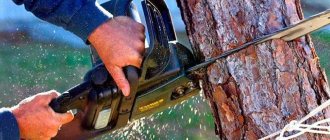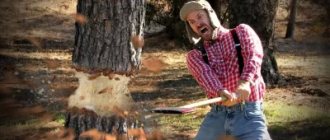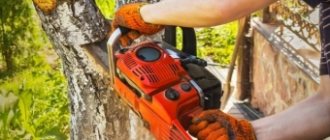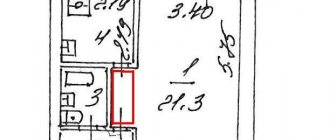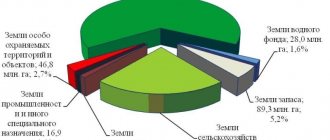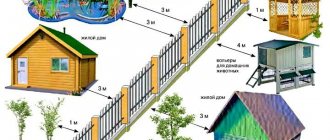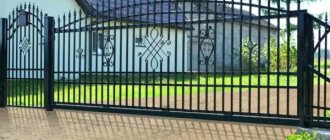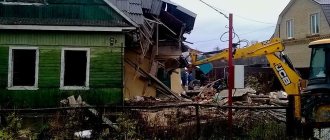Sometimes it becomes necessary to cut down a tree, but before doing this you need to obtain a permit.
Unauthorized cutting down of trees without obtaining a special permit is illegal.
receive large fines or even face criminal prosecution for it .
Therefore it is important to know:
- who issues such permits and under what conditions;
- how much does a permit cost?
- what documents confirm the right to cut down or cut down a tree;
- where to go if you need to remove an interfering plant.
In addition, we will tell you in what cases you can cut down a tree without obtaining permission and avoid punishment for it.
Who has the right to request permission to cut down or cut down?
A tree is the same real estate as a house or apartment, because it is located on a plot of land that has an owner.
According to Article 209.1 of the Civil Code of the Russian Federation, the owner of the plot has the right to independently dispose of his property, therefore only he can apply for permission.
If someone else applies for permission, then in order to consider his application, he must, at a minimum, have a power of attorney to represent the interests of the owner . Therefore, it is impossible to legally obtain a felling ticket or permission to cut down/cut down a tree located on someone else’s property, even if it is a significant nuisance.
The only exceptions are emergency and dangerous trees, however, even for them, only an authorized person can apply for permission. At the same time, the owner of the site may be either against cutting in general or against the use of certain methods, and even a representative of the local government will have to take his opinion into account.
How to get a felling ticket for a plot of land for private household plots
If you have a plot of land for private household plots, then you should contact the administration of your district, namely the land committee, to give clarification regarding the presence of forest plantations on your plot belonging to the forest fund, or the presence of tree species on it, the felling of which is controlled by environmental services in the field of environmental management.
An application for clarification is submitted in simple written form; even if you submit an application to the wrong department or body, then the municipal executive bodies are obliged to transfer it through interdepartmental cooperation to the appropriate place.
Who issues permits?
In most cases, such permits are issued by the Department of Natural Resources or the Nature Protection Department of the city administration , but there may be situations when its functions are performed by other departments, including the Department of Housing and Communal Services (HPU).
Most cities have their own procedure for issuing permits with a list of organizations that provide such services.
You can often order a permit through the “Single Window” service; in this case, the entire package of documents will be sent to the official who deals with these issues, and the land owner will not have to run around offices and ask who issues permits or logging tickets.
Who should pay for tree removal?
Felling or sawing, like any other work, must be paid for, but it is not always possible to say for sure who should finance this process . If the plants prevent the land owner from implementing any of his plans, then all costs of removing the plants fall on his shoulders.
However, when a plant poses a danger, the situation is not so clear-cut, because the owner of the land may not have the means to pay - the cost of cutting down and restoration measures often amounts to tens of thousands of rubles.
In this case, the owner of the house must contact the local administration with a written application , then his application will be considered by specialists, and the real financial situation will also be taken into account. If the threat posed by the plant and the insolvency of the owner of the house are confirmed (often they are single disabled people or pensioners), then the administration will solve the problem at its own expense.
If an emergency or dangerous tree grows on lands owned by a legal entity and its representative wants to remove the source of danger, then all work will be performed at his expense. All these issues should be spelled out in more detail at the level of local legislation , as provided for by the Federal Law “On the general principles of organizing local self-government in the Russian Federation” dated October 6, 2003 N 131-FZ.
Receipt procedure
Preparation for filing an application for a permit must begin with the collection of documents, a complete list of which will be provided by employees of the department or department dealing with these issues.
The basic package will necessarily include documents confirming ownership of the plot .
This can be either an extract from the Unified State Register of Real Estate (USRN) or other documents.
The package also includes a statement in which the owner of the site describes the coordinates and purpose of the site, as well as the main parameters of the tree, that is:
- breed;
- dimensions;
- age;
- location on the site;
- reasons why felling is required.
In addition, the application must indicate an agreement to pay for an examination of the tree and payment of an environmental fee.
After this, a specialist will visit the site to assess the condition of the tree, as well as the degree of threat it poses. If the plant is not valuable or especially valuable, and also in cases where its age, and therefore its thickness, has not reached a certain value, then instead of a permit, the applicant will receive a notice that a permit is not required to remove this tree.
Most often this applies to fruit varieties, especially hybrid ones, as well as trees whose age does not exceed 30–50 years.
If suddenly a tree turns out to be valuable, then the specialist assesses the degree of threat it poses and the amount of expenses necessary to restore the green fund.
This requirement is based on Federal Law No. 7-FZ of January 10, 2002 “On Environmental Protection,” however, each region and large city, and often small towns, has its own procedure for calculating such fees, taking into account local factors.
Having made sure that all the data specified in the application is correct and the tree really interferes or poses a threat, the specialist will transfer the application and his conclusion on it to a special commission under the city or district administration. After the application is approved by the commission, the applicant is given a permit, which specifies the coordinates and address of the site and the location of the tree on it relative to other trees.
If several trees growing next to each other are intended to be cut down, then in addition to permission you must
obtain a felling ticket , but there is a possibility that you will have to obtain one even for cutting down one tree.
After all, these issues are regulated by laws issued by the local government.
Having received permission, you need to find an enterprise or private entrepreneur who can do this work and enter into an agreement with him for the provision of services .
After this, you must pay for the tree removal services, as well as the fees required by law, and submit all documents, including approval, to the Department of Environmental Management.
Often, enterprises and entrepreneurs involved in tree removal independently obtain a permit and felling ticket for a small fee.
In this article you will find detailed information about:
- selection of contractors;
- the work they perform;
- the cost of their services.
Summarizing
If you plan to fell or cut a tree yourself, you should definitely watch videos of how professionals do it. Safety comes first. The main risk factor when sawing trees at height is a chainsaw . It must be constantly monitored and monitored so as not to cut the safety rope.
When felling an entire tree from the ground, you need to think in advance about where to run back if something goes wrong. You also need to remove anything that could cause you to trip over it, and protect the area from possible onlookers. The easiest way to cut down living trees. In some cases, a dried tree can only be cut down using special equipment.
There is a topic on the portal that tells you how to legally cut down trees and how to cut down trees correctly.
We also recommend articles on how to survive on a site while there is no home, how to organize the life of workers during construction, and how to dig a pit for the basement floor.
The video shows how to choose a chainsaw depending on the tasks at hand.
Different situations
Despite all the benefits that trees bring, sometimes situations arise when they get in the way or are a source of danger . Therefore, we will tell you who has the right to act in such situations and how, as well as what to do if a tree is in the way, but according to the law you cannot remove it yourself.
Next we will tell you whether it is possible to cut down trees:
- on your site;
- on a neighbor's property;
- in the courtyard of a multi-storey building;
- in the city;
- In the woods.
On your site
Despite the fact that paragraph 1 of Article 209 of the Civil Code of the Russian Federation gives the right to the land owner to independently dispose of his real estate, including cutting down trees on his site, it is necessary to take into account the requirements of other documents, first of all :
- Forest Code of the Russian Federation.
- Code of Administrative Offenses (CAO).
- Land Code.
- Federal Law of January 10, 2002 No. 7-FZ “On Environmental Protection”.
- Order of the Ministry of Natural Resources and Ecology of the Russian Federation dated September 13, 2021 No. 474 “On approval of the Rules for timber harvesting and the specifics of timber harvesting in forest districts and forest parks specified in Article 23 of the Forest Code of the Russian Federation.”
Unfortunately, in Russian legislation there is no single document that would answer in detail the question of whether it is possible to cut down trees on your site. In addition, there is no clear concept of a forest as a group of trees, so in some settlements a single tree of a non-valuable species can be removed even without obtaining permission, while in others the result of such cutting can be a large fine or even the initiation of a criminal case.
In most cases, such cases fall apart in court, because there is no clear prohibition on such actions , but this is not a guarantee that this will always happen. Therefore, in order to calmly cut down a tree on your property, it is still better to obtain permission.
The same applies to the need to cut down a tree on a summer cottage - before doing this, it is advisable to obtain permission to cut down a specific object, this way you will protect yourself from possible consequences.
On a neighbor's property
All trees located on private property are the property of the owner of the site, and also have a certain price, which depends on factors such as :
- breed;
- age;
- size;
- location on the site.
Any attempt to cut down a neighbor’s tree without permission is a sufficient reason for him to contact the police , because there is a threat to his property, and it is protected by law.
Therefore, it is necessary to negotiate about the disturbing tree, because only the neighbor, as the owner of the land, has the right to legally remove it.
In the courtyard of an apartment building
The adjacent territory can be either jointly owned by all owners of apartments in an apartment building, or belong to some other private or legal entity.
In any case, only the owner can decide the fate of a disturbing or dangerous dilapidated tree, that is, either a meeting of residents of the house , if the local area is registered as property, or the one who owns the land .
Any attempt to remove a tree without authorization will be perceived by law enforcement as causing financial harm.
Moreover, the calculation will take into account not only the property of the tree, which will be determined during the taxation process, but also the cost of restoration measures, during which the impact on the environment should return to the state before the removal of the plant.
Therefore they will take into account :
- seedling cost;
- payment for delivery and drop-off;
- plant care costs.
In the city
Any piece of land within the city limits, and therefore the tree growing on it, is on the balance sheet of some owner . In most cases, the land belongs to the municipality, but may belong to a legal entity or individual.
Illegally cutting down a tree within the city, without obtaining permission from the owner of the site, will lead to serious problems.
To remove such a tree, you must either obtain permission to cut down trees in the city from the owner, or somehow convince him to carry out all the work himself.
In the forest
Article 5 of the Forest Code of the Russian Federation does not provide a clear definition of a forest, calling it an ecological system and a natural resource. Therefore, the concept of forest includes both a solitary tree growing and huge artificially planted or wild groups of trees.
Article 6 of the LC states that forests are located on lands of the forest fund and other categories. These categories are described in Article 7 of the Land Code of the Russian Federation.
Forest lands always
belong to the state , so any attempt to cut down a tree in the forest in these territories is grounds for administrative or criminal prosecution.
Forests located on sites for other purposes may belong to legal entities or individuals who own these sites, therefore, to remove a tree, it is necessary to obtain permission from the owner of the site.
Therefore, unauthorized cutting down of a tree in the forest is always a violation of the law. To remove it legally, the owner's consent is required.
In addition, even if the forest is located on a privately owned plot, there is a high probability that in addition to the permission of its owner, permission from the forestry department, nature conservation department or other departments/organizations will also be required . This is due to the fact that some of the forests located on private plots are classified as specially protected, so even after receiving permission from the owner, it is better to consult on this issue with the city or district administration.
Signs of an emergency or dangerous object
Here are the main signs of trees in danger of being cut down:
- There are noticeable or invisible defects on the trunk or branches that may cause damage to health or property if the trunk or branch falls.
- When moving under the influence of wind or other factors, the trunk or branches can damage communications or any movable/immovable property.
- Further growth of the tree poses a threat to real estate.
If the trunk or branches can potentially cause damage as a result of movement or falling, then the tree is classified as emergency, that is, posing a moderate danger. Moreover, even a plant that, upon a quick inspection, seems absolutely healthy , has to be considered emergency, because it is impossible to look inside the wood without damaging it, and there are no other ways to reliably determine the condition of the tree.
If this tree has any manifestations of internal defects , such as:
- dried branches;
- cracks in the bark;
- hollows;
- mushrooms growing on the trunk or branches;
- incorrect angle between the trunk and branches;
- any lesions of the cortex;
- change in foliage color that occurred before leaf fall,
then it is transferred to the category of dangerous , requiring immediate cutting.
Also included in the emergency category are trees whose crowns or branches touch communications and external elements of buildings, including roofs and windows.
During the wind, the crown and branches move and affect communications and external elements of buildings, and the stronger this impact, the higher the level of danger that the plant poses.
Some of the dangers created by such trees can be eliminated with the help of competent pruning , that is, removing several branches, however, permission must be obtained for this operation. If there are any manifestations of wood defects on the plant, then the danger can only be eliminated by cutting it down.
Emergency trees also include those trees whose roots pass under the foundations of various buildings . This usually occurs when the wrong place to plant a tree or foundation is chosen. While the plant is young, its roots are quite thin, so they do not pose a threat, but as it matures, not only above-ground, but also underground wood grows.
When the root reaches a certain size, it begins to lift the foundation, which is why the latter becomes covered with cracks and collapses. The only way to prevent such a development of the situation is to replant, and if this is not possible, then to remove the tree.
Responsibility for illegal cutting
Illegal tree cutting is an administrative and, in some cases, a criminal offense . Responsibility for illegal cutting is prescribed in Article 260 of the Criminal Code of the Russian Federation and Articles 8.25–28 of the Code of Administrative Offenses of the Russian Federation.
The problem is that there is no clear concept of a forest, so the severity of damage to nature is determined by a person, and based on his own understanding. In addition, when determining the amount of damage, not only the cost of the destroyed plant is assessed, but also the costs of restoration work.
For cutting down a young fruit tree on someone else's or state territory, you can get away with a small fine, but if you cut down a plant of valuable species, and even of a considerable age, then the damage may be so great that the offender will be subject to criminal liability.
In addition, fines are provided not only for unauthorized logging, but also for violation of the procedure for obtaining a permit. Therefore, the service of obtaining a permit and a felling ticket, which is provided by many arborists and companies involved in cutting down trees, is very popular.
Errors in paperwork, taxation of trees intended for cutting down and calculation of the cost of restoration measures also lead to fines, albeit smaller ones. The fine for all types of violations committed during the removal of trees falls within the range of 4 thousand - 3 million rubles .
In addition, timber taxation and the cost of restoration measures greatly depend on the region and its climate. Therefore, in the northern regions, the total amount of damage may be noticeably higher than in the southern regions, because growing a tree there is much more difficult.
Where can you legally cut down trees without a permit?
You can cut down trees on your property without permission if it is privately owned.
In this case, conditions must be met :
- There should be no rare or particularly valuable breeds.
- The site should not be adjacent to the forest or located nearby.
- The age of trees should not exceed a certain level (depending on the region and species).
- The number of trees removed should be small (1–2 pieces).
- Trees to be removed should not be located in habitats of endangered birds and animals listed in the Red Book.
- Removing trees will not cause negative reactions from neighbors or environmentalists.
- It is necessary to think through and implement a recovery plan.
If any of these points are not met, then before starting cutting or sawing, it is advisable to obtain a permit . In this case, all responsibility will lie with those who issued the permit.
In addition, the removal of trees negatively affects the amount of oxygen in the air, so restoration measures are needed not only by the state, but also by the owner of the site, because the more plants there are, the cleaner the air will be.
Why cut down trees?
City dwellers appreciate greenery in their yards. The need for space cleaning arises for several main reasons:
- branches block the light in the window or interfere with the view;
- the tree is in disrepair and may fall from a gust of wind or snow;
- the root system of the plant interferes with communications to a private building.
Tip: Large plants, according to building codes, must be located at least five meters from the foundation of the building. The rule was adopted on the basis that a powerful root system can damage a residential building.
Conclusion
Obtaining permission to cut down is necessary not only to avoid administrative or criminal liability, but also to preserve the environment, because uncontrolled cutting has a negative impact on the environment and reduces the amount of oxygen in the air.
After reading the article, you learned:
- why it is necessary to obtain permission;
- who issues it;
- how and from what the cost of a permit is formed;
- What is the punishment for illegal cutting or felling of trees?
Penalties
When trees belonging to forest plantations grow on the site, you need to be as careful as possible when cutting them down.
You should find out what category of land the site belongs to and what types of permitted use it has. Forest trees cannot be cut down without permission, even if they are located on a private plot.
This limitation is established by the Forest Code of the Russian Federation. For cutting down trees without permission, the perpetrator is punished with a fine. The size of the fine in different regions does not differ much, so for reference you can take the indicators, for example, of the Moscow region.
In this region, you will have to pay from 3,500 to 4,000 rubles for illegal cutting of trees. This is the amount of monetary punishment for an individual. If a legal entity commits illegal actions, it will pay up to 300,000 rubles; an official - up to 50,000; such amounts are determined by Article 8.28 of the Code of Administrative Offenses of the Russian Federation.
